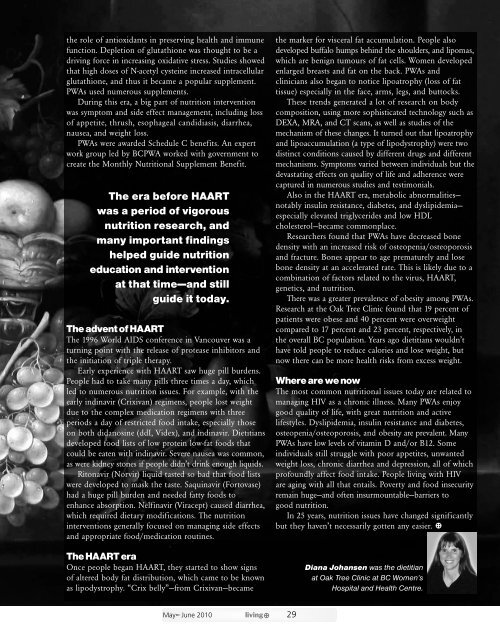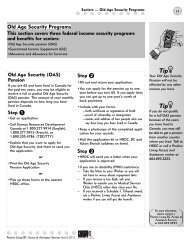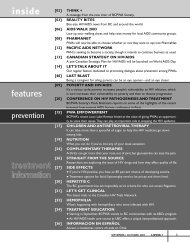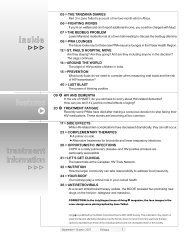liv poz mag.qxd - Positive Living BC
liv poz mag.qxd - Positive Living BC
liv poz mag.qxd - Positive Living BC
Create successful ePaper yourself
Turn your PDF publications into a flip-book with our unique Google optimized e-Paper software.
the role of antioxidants in preserving health and immune<br />
function. Depletion of glutathione was thought to be a<br />
driving force in increasing oxidative stress. Studies showed<br />
that high doses of N-acetyl cysteine increased intracellular<br />
glutathione, and thus it became a popular supplement.<br />
PWAs used numerous supplements.<br />
During this era, a big part of nutrition intervention<br />
was symptom and side effect management, including loss<br />
of appetite, thrush, esophageal candidiasis, diarrhea,<br />
nausea, and weight loss.<br />
PWAs were awarded Schedule C benefits. An expert<br />
work group led by <strong>BC</strong>PWA worked with government to<br />
create the Monthly Nutritional Supplement Benefit.<br />
The era before HAART<br />
was a period of vigorous<br />
nutrition research, and<br />
many important findings<br />
helped guide nutrition<br />
education and intervention<br />
at that time—and still<br />
guide it today.<br />
The advent of HAART<br />
The 1996 World AIDS conference in Vancouver was a<br />
turning point with the release of protease inhibitors and<br />
the initiation of triple therapy.<br />
Early experience with HAART saw huge pill burdens.<br />
People had to take many pills three times a day, which<br />
led to numerous nutrition issues. For example, with the<br />
early indinavir (Crixivan) regimens, people lost weight<br />
due to the complex medication regimens with three<br />
periods a day of restricted food intake, especially those<br />
on both didanosine (ddI, Videx), and indinavir. Dietitians<br />
developed food lists of low protein low-fat foods that<br />
could be eaten with indinavir. Severe nausea was common,<br />
as were kidney stones if people didn’t drink enough liquids.<br />
Ritonavir (Norvir) liquid tasted so bad that food lists<br />
were developed to mask the taste. Saquinavir (Fortovase)<br />
had a huge pill burden and needed fatty foods to<br />
enhance absorption. Nelfinavir (Viracept) caused diarrhea,<br />
which required dietary modifications. The nutrition<br />
interventions generally focused on managing side effects<br />
and appropriate food/medication routines.<br />
The HAART era<br />
Once people began HAART, they started to show signs<br />
of altered body fat distribution, which came to be known<br />
as lipodystrophy. “Crix belly”—from Crixivan—became<br />
the marker for visceral fat accumulation. People also<br />
developed buffalo humps behind the shoulders, and lipomas,<br />
which are benign tumours of fat cells. Women developed<br />
enlarged breasts and fat on the back. PWAs and<br />
clinicians also began to notice lipoatrophy (loss of fat<br />
tissue) especially in the face, arms, legs, and buttocks.<br />
These trends generated a lot of research on body<br />
composition, using more sophisticated technology such as<br />
DEXA, MRA, and CT scans, as well as studies of the<br />
mechanism of these changes. It turned out that lipoatrophy<br />
and lipoaccumulation (a type of lipodystrophy) were two<br />
distinct conditions caused by different drugs and different<br />
mechanisms. Symptoms varied between individuals but the<br />
devastating effects on quality of life and adherence were<br />
captured in numerous studies and testimonials.<br />
Also in the HAART era, metabolic abnormalities—<br />
notably insulin resistance, diabetes, and dyslipidemia—<br />
especially elevated triglycerides and low HDL<br />
cholesterol—became commonplace.<br />
Researchers found that PWAs have decreased bone<br />
density with an increased risk of osteopenia/osteoporosis<br />
and fracture. Bones appear to age prematurely and lose<br />
bone density at an accelerated rate. This is likely due to a<br />
combination of factors related to the virus, HAART,<br />
genetics, and nutrition.<br />
There was a greater prevalence of obesity among PWAs.<br />
Research at the Oak Tree Clinic found that 19 percent of<br />
patients were obese and 40 percent were overweight<br />
compared to 17 percent and 23 percent, respectively, in<br />
the overall <strong>BC</strong> population. Years ago dietitians wouldn’t<br />
have told people to reduce calories and lose weight, but<br />
now there can be more health risks from excess weight.<br />
Where are we now<br />
The most common nutritional issues today are related to<br />
managing HIV as a chronic illness. Many PWAs enjoy<br />
good quality of life, with great nutrition and active<br />
lifestyles. Dyslipidemia, insulin resistance and diabetes,<br />
osteopenia/osteoporosis, and obesity are prevalent. Many<br />
PWAs have low levels of vitamin D and/or B12. Some<br />
individuals still struggle with poor appetites, unwanted<br />
weight loss, chronic diarrhea and depression, all of which<br />
profoundly affect food intake. People <strong>liv</strong>ing with HIV<br />
are aging with all that entails. Poverty and food insecurity<br />
remain huge—and often insurmountable—barriers to<br />
good nutrition.<br />
In 25 years, nutrition issues have changed significantly<br />
but they haven’t necessarily gotten any easier. 5<br />
Diana Johansen was the dietitian<br />
at Oak Tree Clinic at <strong>BC</strong> Women’s<br />
Hospital and Health Centre.<br />
MayqJune 2010 <strong>liv</strong>ing5 29











